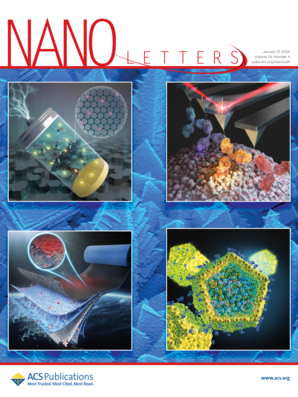反铁电PbZrO3薄膜中原子尺度极性涡-反涡对的观测
IF 9.1
1区 材料科学
Q1 CHEMISTRY, MULTIDISCIPLINARY
引用次数: 0
摘要
拓扑极性结构与自旋涡和天际线类似,在未来的器件应用中具有令人着迷的前景,受到了极大的关注。然而,在广泛研究的铁电基超晶格中,外延异质界面产生所需的应变、退极化和梯度能,极大地限制了拓扑孤子的迁移率。在这里,我们报道了用原子分辨率扫描透射电子显微镜观察到反铁电PbZrO3薄膜反相边界结附近的极性涡-反涡对。我们的时间分辨晶格分析表明,由不相称调制引起的局部应变梯度构建了迄今为止报道的最小拓扑单元。我们的相场模拟揭示了Pb-O空位诱导的随机电场可以解释它们的三维形成,电子束辐照的刺激可以驱动它们的动态迁移。这一发现为理解反铁电的基本物理学和基于反铁电薄膜拓扑结构的功能器件设计提供了新的途径。本文章由计算机程序翻译,如有差异,请以英文原文为准。

Observation of Atomic-Scale Polar Vortex–Antivortex Pairs in Antiferroelectric PbZrO3 Thin Films
Topological polar structures, in analogy to spin vortices and skyrmions, have received tremendous attention for their fascinating prospects in future device applications. However, in the widely studied ferroelectric-based superlattices, the epitaxial heterointerfaces, yielding desired strain, depolarization, and gradient energies, greatly confine the mobility of the topological solitons. Here, we report observation of polar vortex–antivortex pairs near junctions of antiphase boundaries in antiferroelectric PbZrO3 thin films by using atomic-resolution scanning transmission electron microscopy. Our temporal-resolved lattice analysis reveals that the local strain gradient caused by an incommensurate modulation constructs the smallest topological units reported to date. Our phase-field simulations unveil that the Pb–O vacancy-induced random electric fields account for their three-dimensional formation, and the stimulus of electron-beam irradiation can drive their dynamic migration. The findings offer a new approach to comprehend fundamental physics about antiferroelectricity and the design of functional devices based on topological structures in antiferroelectric thin films.
求助全文
通过发布文献求助,成功后即可免费获取论文全文。
去求助
来源期刊

Nano Letters
工程技术-材料科学:综合
CiteScore
16.80
自引率
2.80%
发文量
1182
审稿时长
1.4 months
期刊介绍:
Nano Letters serves as a dynamic platform for promptly disseminating original results in fundamental, applied, and emerging research across all facets of nanoscience and nanotechnology. A pivotal criterion for inclusion within Nano Letters is the convergence of at least two different areas or disciplines, ensuring a rich interdisciplinary scope. The journal is dedicated to fostering exploration in diverse areas, including:
- Experimental and theoretical findings on physical, chemical, and biological phenomena at the nanoscale
- Synthesis, characterization, and processing of organic, inorganic, polymer, and hybrid nanomaterials through physical, chemical, and biological methodologies
- Modeling and simulation of synthetic, assembly, and interaction processes
- Realization of integrated nanostructures and nano-engineered devices exhibiting advanced performance
- Applications of nanoscale materials in living and environmental systems
Nano Letters is committed to advancing and showcasing groundbreaking research that intersects various domains, fostering innovation and collaboration in the ever-evolving field of nanoscience and nanotechnology.
 求助内容:
求助内容: 应助结果提醒方式:
应助结果提醒方式:


